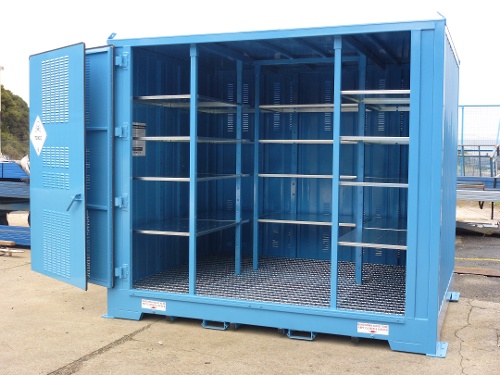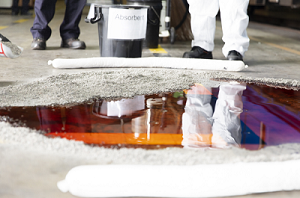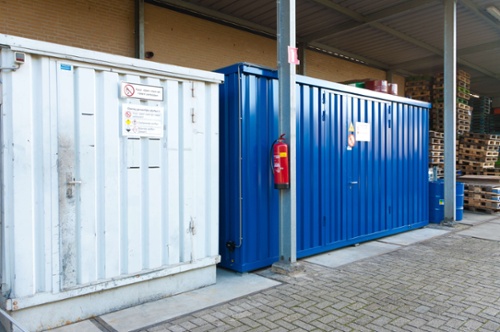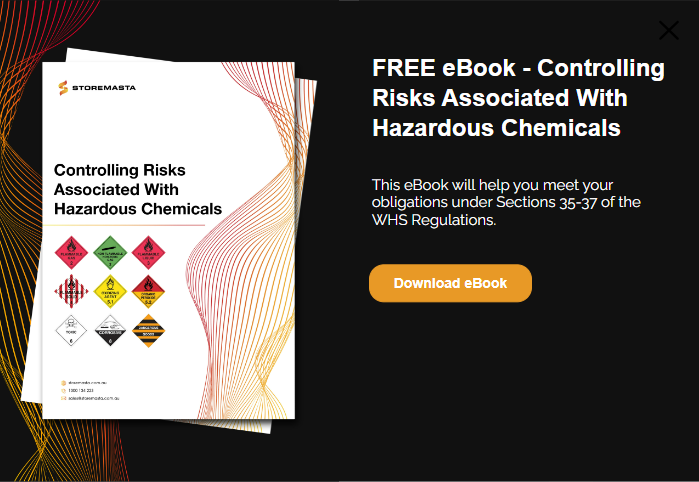With a range of chemical storage containers on the market, it’s often hard to determine which type of container you’ll need for your workplace. In this blog, we look at the relocatable DG container and unpack 7 key reasons that you should consider using one in your organisation. We’ll also explain how this storage method can improve safety and efficiency in workplaces that carry larger amounts of dangerous goods.
But before we get into it, let’s first explain what exactly a DG container is.
What Is A DG Container?
A DG container, or dangerous goods container, is a portable chemical storage container that’s designed to house a specific class of dangerous goods. DG containers are available in a range of sizes, with the most common sizes being 10ft or 20ft containers. These containers are used to store larger quantities of hazardous chemicals, with most containers capable of storing thousands of litres of chemicals.
DG containers can house a range of chemical packages such as containers, drums and IBCs. DG containers are often equipped with a multitude of control measures to prevent hazards such as chemical spills and the build-up of hazardous vapours.

DG containers are designed to carry large volumes of hazardous chemicals and dangerous goods.
What Type Of Workplace Uses Them?
Any business that wishes to store larger quantities of chemical packages in the outdoor environment can consider installing a DG container at their site.
These relocatable containers are often used on remote worksites, as they are easy to transport and install. They are also a common storage solution for almost any type of workplace that has a secure outdoor space. Industries which use dangerous goods containers include mining, oil & gas, agriculture, manufacturing, construction, education, defence, equipment maintenance and many more.
Compliant DG Containers
There are certain requirements in Australia that affect the design and construction of compliant dangerous goods containers. These requirements are detailed in the Australian Standard for the particular class of dangerous goods that you’re looking to store.
To comply with WHS Regulations and meet the requirements of the Australian Standards, you should look for a DG container that is constructed in full conformance with the Standard of the chemical class that you’re carrying.
You should also consider the various additional requirements that relate to your store, including the installation location, isolation and segregation guidelines, how the container is used, and the housekeeping practices that are applied to the store. By following the requirements of the Australian Standards, your organisation will ensure the ongoing compliance of your container.
7 Key Reasons To Use A DG Container
While the key benefit of using a DG container is to provide a safe and compliant space to house your hazardous chemicals and dangerous goods, there are many specific reasons organisations should consider this form of chemical storage. Here are 7 key reasons to use a DG container to store hazardous chemicals outdoors in your workplace.
1. Made To Be Moved
Whether you want your container to stay onsite for many years, or you need a chemical storage system for a remote work site, dangerous goods containers are a type of chemical store that’s specifically designed to be transported. Container features may include forklift channels, lifting lugs and locating plates — which will make the relocation of your container a safer and simpler task.

Your container is made to be moved and should feature forklift channels, lifting lugs and locating plates for safe transporting.
2. No Need For Mechanical Ventilation
If businesses are storing larger volumes of hazardous chemicals, there is always the risk that a high level of dangerous vapours will be emitted from the chemical store. While there are certain work and housekeeping practices that can reduce the build-up of hazardous vapours, it’s important to consider the ventilation system of your chemical store.
DG containers are usually equipped with natural ventilation to allow for the dispersion of hazardous vapours. While you may need to consider a mechanical ventilation system for some indoor cabinets or chemical stores, dangerous goods containers with at least two walls of louvres can effectively reduce the build-up of vapours. This will allow your worksite to remain compliant and stay within the legal vapour concentration limits — which are listed in Safe Work Australia’s workplace exposure standards.
3. Built In Spill Containment
DG containers should be equipped with a liquid-tight spill containment system, so any chemical leaks or spills are directed into the sump. When you’re storing any type of hazardous substance in any volume, spill containment should also be one of the key priorities. However, when you’re carrying large amounts of chemicals and they’re stored in an outdoor environment, there is an increased risk that a chemical spill could quickly spread through your workplace and enter the natural environment through drains, soil and waterways. By having the correct spill containment system in place, your DG container offers excellent protection against hazards such as environmental damage, hazardous vapour emissions, human harm, fire and explosion.

A compliant liquid-tight spill sump can effectively contain any chemical leaks or spills that may occur in your outdoor store.
4. Stackable Storage
Some dangerous goods containers offer extra flexibility for workplaces due to their relocatable and stackable design. Our DG containers have a 12-tonne lift rating, which means that they can be raised when full of your (unopened) chemical packages. These containers can also be stacked 3 high in workplaces where it is feasible and safe to do so.
When considering the instalment of your dangerous goods containers, make sure you factor in things such as ease of manoeuvrability, placing the containers away from areas where people may congregate, allowing enough space for emergency evacuations and locating the containers in an area that is not likely to suffer from impact damage. While these containers are relocatable and stackable, planning your outdoor space to allow for the safe movement of forklifts and staff is an essential consideration.
5. Walk-In Design
How do you use your chemical packages? Will they remain unopened in your container? Or do you need to transfer, pump or decant chemicals from your storage facility? As well as being one of the most expansive storage solutions, DG containers also offer businesses a dedicated space to store and use chemicals. When you’re choosing a container, consider your work practices and check if your staff can comfortably decant or pump chemicals from the container.
Dangerous goods containers are some of the largest chemical storage units, with internal heights often greater than 2 metres. Due to the walk-in design and durable fibreglass flooring, staff can freely move around inside the container and carry out their daily tasks. There is also the benefit of a fully bunded floor area that can contain any chemical leaks or spills which may occur during decanting or pumping.
REMEMBER: Chemical storage containers can be customised to suit the needs of your business. Consider optional customisations such as decanting systems, pump stations, shelving and eyewash facilities.
6. Protection For Chemical Packages
While there are many benefits to storing chemicals outdoors, your store must be constructed in such a way that protects the stored packages from the weather and impact damage. Compliant dangerous goods containers are manufactured to meet Australian Safety Standards, with a durable sheet steel construction that can prevent chemicals being damaged by vehicles, fallen tree branches or other debris.
DG containers can be customised to suit the conditions of your outdoor environment with extra corrosion protection and higher cyclone ratings.
Unlike indoor safety cabinets or standard shipping containers, DG containers are manufactured to meet the demands of the outdoor environment. Features may include natural ventilation (for vapour dispersion and temperature control), cyclone protection (for our harsh Australian environment) and a cambered roof (for efficient rain runoff).
IMPORTANT: If you’re storing your chemicals in a coastal location or one that is prone to strong winds and cyclones, ask your DG container manufacturer about the benefits of opting for a higher cyclone rating and extra corrosion protection.
7. Secure Outdoor Chemical Storage
To prevent unathorised entry into your chemical storage container, it’s important to have security measures in place. Being in the outdoor environment, chemical stores can be at risk of theft, misuse or vandalism.
Compliant DG containers must be equipped with a security mechanism, such as ISO locking bars, to prevent unauthorised entry. This is not only to protect your business from the financial cost of theft, but it’s an important risk control measure when you’re storing large quantities of dangerous goods.
Selecting Dangerous Goods Storage
If you’re searching for DG containers for sale, take the time to consider the compliance and features of your storage container. As we’ve highlighted in this blog, this type of container is a flexible and convenient solution for a range of businesses including mining operations, manufacturing facilities and equipment maintenance businesses. When selecting your DG container, make sure you ask the supplier or manufacturer if the storage container is constructed in full conformance with Australian Standards. Only containers made to meet the requirements of the Standards will offer your business the highest standards of protection.
To learn more about controlling chemical hazards in the workplace, you can access our free eBook. Controlling Risks Associated With Hazardous Chemicals is an easy-to-read guide which will help you eliminate hazards through choosing the best risk control measures. Get your copy for free today by clicking on the image below.
Joining the team as a Dangerous Goods Storage Consultant, Melissa Hampton became Storemasta's Marketing Manager in late 2021. With extensive knowledge and experience in chemical compliance, Melissa is responsible for leading the Marketing team and helping shape their marketing strategy. In her spare time, you can find Melissa hiking, swimming and enjoying the great outdoors in beautiful north-west Tasmania.

